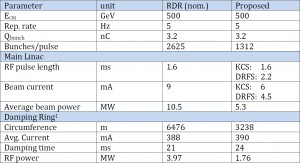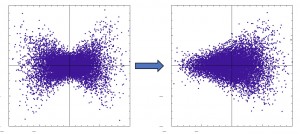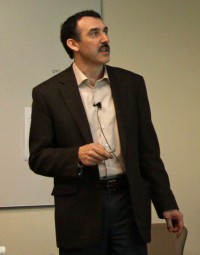
A comparison of the reduced parameter set with those from the {plain}Reference Design Report{/plain}. Note the parameters are shown for two different high-level radiofrequency schemes.
Cost containment has been a consistent theme underlying proposals to define a new baseline for the technical design effort and report. Some changes are the result of further studies after we developed a reference design for the ILC, while others have required invoking some new ideas. One of the four major changes that were proposed in a proposal document from the Global Design Effort (GDE) project managers was to reduce the number of bunches in the machine. This gives a corresponding reduction in the main linac beam current, consequently reducing the number of klystrons, modulators, power supplies and other machines, and requires a smaller damping ring. I have approved this change due to the significant cost savings and following extensive studies of options for recovering the luminosity, including innovative schemes like employing stronger focusing techniques at the interaction point.

Increasing luminosity by around 30% is proposed by using travelling focus technique to shift the waist for each z beam slice such as to maximise interaction rate.
The total cost of the International Linear Collider is comparable to the total investment that has been made in all the subsystems of the Large Hadron Collider. The LHC is in the process of opening up a new energy frontier, the terascale, and our first serious look at that science should be presented within the next couple years. Governments are not ready to consider building the ILC as a global project, at least until the science is justified by results from the LHC. Those results may well guide the machine parameters, and we remain flexible depending on what is learned.
In the meantime, the GDE is carrying out the second step in its mandate, to complete a technical design for the ILC that is complete and reliable enough to be used for proposals to collaborating countries and as the basis of undertaking a major construction project. The technical design will be based on our earlier reference design, but with some key changes that optimise cost, risk and performance. We are putting special emphasis on changes that can result in cost savings, so that we can contain cost growth as much as possible.

Andre Seryi discussing the potential luminosity gained by using the travelling focus technique at the January SLAC Baseline Assessment Workshop.
The proposal to adopt a reduced parameter set involves a series of changes to accommodate halving the number of bunches in the machine. In addition to the changes in the main linac, we propose another significant change of reducing the diameter of the damping ring circumference by a factor of two. However, to ensure that we can accommodate more bunches, if needed or desired at a later time, we also propose increasing the diameter from 5 metres in the Reference Design Report to 7.5 metres for the Technical Design Report, allowing the possibility of installing one electron and two positron rings in the tunnel.
Our plan is to restore the luminosity through the use of stronger focusing in the interaction region, for example employing something like the travelling focus scheme. However, we are explicitly maintaining the conventional facilities and other infrastructure needed to be able to upgrade to the original number of bunches at a later time, either as risk mitigation or possibly for a luminosity upgrade of the machine.
I want to commend the project managers for both evolving their original proposal for a reduced parameter set to satisfy the risk concerns stated by the GDE Program Advisory Committee and performance concerns of the physics community. I also emphasise that over the past year the four proposals for baseline changes that have been considered significant enough to need approval by a change process and approval by the director have gone through a very open and interactive process to get to mature proposals, ones that have been evaluated rather straightforwardly by a change assessment panel. The panel recommends whether to make the changes and makes suggestions for further directions as the technical design is carried out.


Wiki says the ILC is supposed to investigate the so-called Higgs boson, “extra dimensions,” and the shaky hypothesis of supersymmetry, all of which should soon be disproved by the LHC present half-power and future high-power runs. Why then bother with the ILC?
Low-energy atomic and subatomic relations have hardly been looked at and have the potential to revolutionize human thought. The human race won’t get there by chimerical pursuit of mythical species at high energies where, in any case, astrophysical investigations hold as much or even more promise.
The nature of self-interaction of nuclei, in other words, the true and complete theory of the nucleus and its self-communication (with its constituents) and its relations to the surrounding electron fields are subjects hardly touched yet, passed by in the race for high-energy (bomb-grade, as it were) studies.